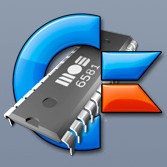I’m not a true mechanical keyboard enthusiast. I mean I like a good keyboard for typing code, so I rolled with model-Ms in the 80s and 90s, then some expensive Cherry keyboard I only recently retired because it was utterly spent (and it was PS/2), and now I happily use a Wooting Two HE.
I’m so glad the mechanical gaming keyboard scene has developed so much: it means there’s a plethora of really excellent keyboards for the rest of us who don’t play games.
But something utterly baffles me: why are high-quality keyboards getting smaller?
There’s a lot more keyboards without the numpad and the block of middle keys - whatever they’re called - or with the middle keys reduced or squashed up awkwardly on the side, than full-size plain old 102- or 104-key layout keyboards. What’s wrong with the numpad? Isn’t more keys generally better?
Back in the days, I bought the original Happy Hacking keyboard because it kind of made sense to maneuver around in our server room with a small keyboard that took up less space. Typing on it drove me up the wall but it was convenient to carry. And I guess it was also good option for going to LAN parties with a smaller backpack. But other than that, for a keyboard that never leaves your desk, I don’t get it.
Are there other advantages to smaller keyboards? Genuine question! I’m not dumping on smaller keyboards: to each his own and if you’re happy with yours, more power to you. I’d just like to know why you prefer smaller.
I dont prefer smaller, because at work when I’m in the office I do a lot of spreadsheet work and consequently use the numpad and arrow keys alot.
At home while gaming I almost never use them and never did, had mini keyboards for years but sometimes I have to use my computer for actual work and lo and behold if my halds and fingers dont immediately start looking for the numpad…
I liked having less space between my hands (left hand on the keyboard, right hand on the mouse). I also rarely use the numpad and other keys, so the negligible sacrifice was worth it for better ergonomics.
I switched to a TKL (tenkeyless) to reduce the distance between my hands when my right hand is on the mouse, and it feels so much better.
I got a programmable keyboard, so I remapped the keys around where my right hand rests to be the numpad keys when I hold the capslock key. That way I can still have the convenience of the numpad without having an actual dedicated numpad, although I’m still getting used to using it this way.
Smaller keyboards:
- Encourage you to move your hands less. Part of this is allowing your mouse to be closer, especially if you’re right handed.
- Aesthetically look cleaner and less cluttered
Point 2 is absolutely subjective, though. Personally, I think a full size or TKL look a lot better than a compact. It’s too distracting seeing something “missing” from a traditional setup. Though, I also like to have my keyboard and mouse a good distance from each other and spread out, rather than close and centered in front of me.
This is it for me, I basically don’t use those keys daily and can access them via a function key when I rarely need them, so I’m gonna prioritise the aesthetics and compactness.
For me, having the symbols I use in a function layer is better than having them spread around, because I don’t have to move my hands as much.
I use a keyboard with 64 keys (Keyboardio Model 100), with a layout that would likely drive any normal person mad: there are no numbers on the base layer, and all modifiers are on the thumb cluster. My top row is shifted symbols like
@*$^%!&. I love it. I can reach every key without moving my hand, which helped tremendously with my RSI. With clever use of layers, one-shot modifiers & layers (where one-shot means that you press and release a modifier, and it remains active for the next keypress only), I have access to every symbol available on a traditional layout and more, without having to move my hand or do weird finger gymnastics.It’s not a keyboard I’d normally carry (it’s heavy, split, and takes up more space than a traditional full-size one), that’s not why I like it small. I like it small because I don’t need to move my hand to reach all the keys, and that increases my typing comfort a lot. I have no use for a dedicated numpad: I can just press my right palm key and turn that half of my keyboard into a numpad. If I’m typing a single digit, I don’t even need to hold the palm key. If I’m typing a longer number, I can double tap the palm key to toggle the numpad layer on, and tap it a third time once I’m done. I don’t need cursor keys, because I can tap the left palm key to turn the keyboard into navigation mode: the right side controls the text cursor (ie, arrow keys, page up/down, home/end), and the left side controls the mouse. Most of the time, I don’t even need a mouse, because I can control the pointer from the comfort of my keyboard. I do have a trackball placed inbetween the two halves for the rare cases where I require more mousing than what is comfortable with keys, but… that’s not used all that often.
So, in short, the reason I prefer small and split is because they let me type without moving my hand, or stretching my fingers uncomfortably, and I still have convenient access to every symbol I need. I might need to do a bit more “work” to type certain things, but that’s a small price to pay for the comfort I gain by not having to move my hands.
I can write at ~120WPM with this setup (but I normally don’t need to, my normal typing speed is closer to ~60WPM, because my speed is limited by thinking speed, not my typing speed), I write code with this, I write prose in both English and Hungarian, and I even play some games with it! (Most games I play with a controller though, because I can do that from the couch.)
Just because it is small doesn’t mean it can’t do everything a full-sized keyboard can. I just do the same things in a different way, with different compromises. With a full-sized one, if you want to type numbers, you either have to move your hand to the numpad, or use two hands to type something like 1994. I can type that number with one hand, without moving my hand: instead of moving hands, I switch layers. With a full-sized keyboard, if you need Home, End, PageUp, PageDown or the like, you either need to move your hand, or you need whatever program you’re using to have different bindings for the same functionality. I can just press a key to go into navigation mode, and move the cursor whatever way I like, without moving my hands, or finding an alternative binding - works in every program, anywhere - instead of moving hands, I press an extra key. I found that pressing an extra key (especially if I don’t need to hold it) is more comfortable than moving hands. I also found that not moving my hands increased my accuracy, because I don’t need to find the home position when moving my hand back: it never moved in the first place.
A mystery for me, the numpad is essential and at least 60 percent of the nav cluster is in constant use. And I prefer the full keyboard look
The numpad Is essential or completely useless based on the PC usecase
PC players never use a spreadsheet or the calculator…?
Well of course no! Why should they, honestly! Do you really think a spreadsheet is a daily tool for the average person?
I didn’t say “daily” . If the number pad is there, you can always just… not use it. The opposite doesn’t exactly work.
Imagine you had to swim thru your bathtub to use the toilet every night. Sure it’s nice when you need to bathe, but more often you’re just going to want to skip over it to the thing you do more often—taking a leak. Rather than design your bathroom unergonomically, inconveniently, rearrange it to make more sense. You can buy separate numpads & place it somewhere else on your desk for when you need it, but keep the mouse closer to your keyboard.
I literally don’t understand why you’re so passionately against something some people may want to use. If you don’t use it, fine, it literally takes up about 3 horizontal inches of desk space. And no, it’s not “a bathroom of water you have to swim through multiple times a day”. Also, I’m not about to buy a separate numpad to “keep the mouse close to my keyboard”. That’s absurd, what real-work benefits does that actually provide? You do understand some people do use it, yes?
Being “passionately against something” is my whole modus operandi.
If you use your mouse more than your numpad, you are doing your joints a disservice by not optimizing the ergonomics of your desk setup. I’m really glad we have a lot of options now to get anyone their custom setup unlike the ’90s & earlier. Recent years, separate numpads with good switches are easy to come by as well—heck, if you like mechanical switch over the alternatives, maybe you just want light linear switches for your numbers for your numpad so you can punch those numbers faster & without restraint while having a different switch an your main board.
Perfect answer
Yeah, that seems to be the case
Chances are: they are there on smaller keyboards too. It might not be in the usual spot while also hidden behind a layer but its there.
This used to be a showstopper back when most of the available keyboards are not fully customizable firmware-wise. With the advent of QMK and VIA(L) on a lot of readily available keyboards, however, you can pretty much put any functionalities anywhere on any layer(s) you see fit.
The layer thing is really impressive, I’d actually love to have it on my normal huge keyboard. But I need the numpad available on the first layer, using a mouse is a must in my work
I ditched my numpad when I set up a layer that puts 456 right under jkl. My left hand hits the layer key (how much do you use both your left and right hands while using a numpad) so it’s right there and I don’t even have to move my hand. Doing so let’s me have the essential mouse closer to the boards.
It’s a full numpad, I’ve got the keys setup around it to put + - enter, etc there.
I’ll also add though, it’s an ortholinear so it’s also the same grid layout and a normal numpad.
Well damn that actually sounds good. How much time did it take you to get used to it?
The numpad usage was super quick, but my first (I’ve got a few and all follow that pattern) was a tented, split, ortho keyboard, the Iris. The ortho part for normal typing took me about two weeks or so to get up to normal speed. The split part has definitely helped my RSI though.
I definitely have tweaked my keymap for other special keys and media usage and such along the way. I’ve got the movement arrow keys under my sdf keys (for left, down, right, up on e) as well as of up and down on w&r so that hand doesn’t have to move either. Been living the ortho split life for 6 years now and I can easily type all day at work without any issues. (I’m a DevOps engineer so I do lots of typing, coding, console work all day long)
For a while at work I had a numpadless keyboard and a dedicated numpad placed right of my mouse (I’m right handed), I liked it a lot.
I wanted to try this but all keyboards I use have a numpad. The only thing that worried me was getting used to something you can’t have on every pc
Ironically I set it up so after getting used to notebook’s keyboards that were more centered relative to the screen
I like the ability to remove or add the numb pad depending on the work or play.
Okay that makes sense: it means you have a full-size keyboard for work, a mini keyboard for gaming and you use whichever works best for you for the task at hand.
But that implies there are a lot more gamers with a preference for smaller keyboards than general-purpose typists with a preference for the full-size traditional layout, because the majority of the quality mechanical keyboards offering is smaller keyboards. I have a hard time believing the gaming market is larger than the general computing market.
Or maybe gamers pay more attention to the quality of their keyboards and spend more money on them, making them a more attractive demographic.
I have a 60%, an 87 key, and a full keyboard, and play a fair amount of games, while also doing productive work. The full one is my favorite, and the 87 is close, add I rarely just the numpad, but it’s really nice to have when I do.
There’s some utility in a smaller keyboard, but I’d rather have the function keys than one row less. I barely use the 60% except as my spare keyboard when I need one that isn’t attached to a machine.
Gamers seem to drive the market of people who don’t buy the cheapest or most practical computer accessories, look at RGB lighting in cases. Nice, big mechanical keyboards are hard to find, but not impossible.
I use a mini keyboard for both gaming and work.
For me, the main draw is the size - a smaller keyboard allows you to have your arms in a more ergonomic position (ie, shoulder width apart). For someone who works on a PC all day, ergonomics and posture is imports to me - especially now that I’m older and have suffered from carpal tunnel in the past.
I’ve been using 60-75% keyboard for about a decade now and don’t miss big keyboards at all, neither for gaming, nor for work.
AMA.
Some part of that is that a lot of the mech keyboards are DIY projects, and smaller keyboards are cheaper and simpler to put together.
I personally am a split ergonomic keyboard enjoyer. I use a Keebio Iris at work and a Unikeyboard Diverge TM2 at home, which are a 50% and 40% respectively, both split.
The thing that I like the most about small form factor keebs is that compared to a full keeb, I don’t have to move my hands so much to do basic and oft-repeated tasks. I don’t think about it as removing keys as much as bringing them closer to my fingers. For example, on a 40% keeb, all keys are within 1u away from your fingers’ home position.
I am totally in love with programmable layers. I programmed both of my keebs similarly. Examples:
- The key to the left from the
Akey, usually the Caps Lock key, is a dual-role key on my keebs. When you press it, it acts asEsc, and when you hold it, it acts asCtrl. - I have a key on the left half that makes my right half into a number pad. Just like that, I completely eliminate the need for a physical one, and I don’t even have to move my hand to use it.
- Switching tabs (
Ctrl+Tab,Ctrl+Shift+Tab) is a very often used pair of shortcuts for me, and they’re relatively uncomfortable to press on a full keyboard. I moved them to a much more comfortable position - I hold a key with my thumb and switch tabs with two of my other fingers without having to move any fingers from their home position. - I use virtual desktops in Windows quite a lot for working in different contexts and I mapped switching desktops (
Ctrl+Win+ arrow keys) to a similarly accessible/comfortable position, same with some others likeAlt+F4. - I am a software developer and function keys (
F1-F12) are quite frequently used in IDEs, especially in combination with modifiers (Ctrl,Shift,Alt). With a full keeb you often need to move both of your hands quite far from the home positions to press those combinations. With a small keeb, I use one of my hands to press the modifiers (which I mapped to the home row in most of my layers) and a finger from the other hand moves just 1u up from the home row.
Of course it takes a bit of trial and error, changing the way you think about how the keyboard works, and retraining your muscle memory, but as a person who spends 8+ days working with computers, I think it’s ultimately worth the investment of time, money and effort to make my weapon of choice as ergonomic and comfortable to use as possible.
For when I can’t sit at my desk and use an ergonomic keeb, I also made myself an AutoHotkey script that makes the CapsLock of a regular keyboard more useful. It would be for another writeup, but as an example, it makes it act as
Escwhen you press it and when you hold it, it activates an extra layer – as an example, it turns the keys HJKL into arrow keys (left, down, up, right) and the keys YUIO intoHome,PgDn,PgUpandEnd, and turns the numeric keys into function keys. I can still work with a full-sized keyboard, but whenever I am forced to, I am reminded how clunky it is and I long for my keeb or at least my AHK script.In summary, small keebs are cheaper and easier to make, and they bring all the keys closer to your fingertips, making it more efficient and comfortable than full keebs, with the small cost of retraining your muscle memory.
- The key to the left from the
You can just get a usb number pad for a few bucks.
I find it kind of ironic to spend 300 eur on a custom mechanical keyboard just to pair it with a usb number pad worth “few bucks” though
Numpad not needed since already have number keys above the alphas (and you can buy separate tenkey pads if they’re really needed). The extra space on desktop gained by a shorter keyboard is far more useful. All of mine except two are TKL, the others are 60%. Below that you fall into specialist territory and having typed on QWERTY layouts with function keys for decades I think I’m a bit too old to unlearn and relearn typing, but some people find it fun to use weird and wonderful ortho, dactyl or 40% keebs with multiple programmable “layers”.
I use the numpad quite a bit when entering lots of numbers with one hand. Comes up a bit in drafting, some data entry… Some video games.
This thread has made me curious though. That said I am very attached to my 15 year old logitech keyboard. Done some soldering, cleaned a lot of beer out
I don’t know but I feel the same. My main gripe is with media keys, because I don’t want Fn key combinations, but dedicated media buttons, which is increasingly rare. The most appealing keyboard I have laid eyes on recently is Das Keyboard which has a volume wheel, media keys and is full size, but it’s very pricey and not perfect still.
I use a 64 key keyboard. Barely have to move any of my fingers which is great for reducing my RSI. I hate how standard keyboards just have this one giant key for your thumb. Your thumb is your strongest digit and it’s just used to slap this slab. On the ortho keyboards I’ve become more used to recently often have a thumb cluster so you can have all of your modifiers and whatnot there. Less stretching with your pinky for ctrl, fn whatever (which is how I got my RSI). Having enter, shift, backspace and delete at my … Thumbtips … Is a game changer.
I’m a 65% user and it’s great. The only keys right of the main block that I ever really use are delete, PrtSc, and the arrow keys - so all a full size keyboard does for me is force me to awkwardly bend my arms to the left as I type. I especially dislike numpads on laptop keyboards for that reason.
And I work with numbers a lot. I just prefer the number row. I have remapped the rightmost column of keys to more useful functions as well.
When I used full size keyboard it knocked down my microphone so many times that it became anoying. Moving the keyboard away from microphone wasn’t an option because it wasn’t comfortable for my hands. Moving microphone itself also wasn’t an option because of the cabels and also there is no better position for it on my desk. Combine all of that with the fact that I didn’t even use numpad. Smaller keyboard is so much better for me but I see why some people like full size ones.
Hoo boy. This is an issue close to my heart about which I could talk for an unreasonable length of time.
I’m an accountant. Yes, spreadsheets. I always thought I you’d have to pry my numpad from my cold dead hands.
About 6 months ago I bought one of the saucy little mech boards of which you speak. A keychron k6. It was a whimsical purchase. It would make my thinkpad set up look better when I posted pictures to /r/thinkpad.
Turns out, I love using it so much that I can do without a numpad.
The core element to answer your “why not full size” question is simply that this little harlot fits in my backpack, where a 100% board would not.
Anyhow, I have a d-pad, and 2x function keys that can modify any key to whatever you want. So I don’t miss having any of the extra special keys. It took surprisingly little time to get used to.
On occasion, I do have to grind through entering a list of numbers, but it’s really not that often and doesn’t take that much extra time.
By the way, there is a !thinkpad@lemmy.ml community. Feel free to post there, we need content here on Lemmy. ;)
accountant no 10-key happy
Why must you fill my thread with lies?
(LOL, your post is truly unexpected.)
Accountant here too (well assistant tax adviser doing mainly accounting) and I have the numpad on a layer on the right hand and often used shortcuts on the left hand. It is really nice and only took me like a week to get comfy with.
The extra shortcuts also help a lot, because they are hardcoded into the software and some of them are pretty dumb (shift+F8 and ctrl+numpad / f.e.).
One thing I haven’t seen in this thread yet is how lower number keys allow for an even split and this ergo boards that allow for better posture, especially for the shoulders.
I do have to grind through entering a list of numbers
Have you considered a numpad layer? They’re great. All of the speed and convenience with none of the wasted space or extra arm movements.
I have a numpad for both hands on my Redox :-)

Woah that’s cool. Gonna check that out.
The K6 is not programmable out-of-the-box, but it seems some people have successfully installed QMK firmware on it (with caveats); https://github.com/CanUnesi/QMK-on-K6/
If you just want to try the numpad thing out, it might be easier to use something like AutoHotKey. Here’s an example of a script that uses CapsLock to toggle the numpad layer.
Of course, AHK scripts only work with the computer you’ve installed them to, whereas using programmable firmware will work regardless of which device you connect your keyboard to.
- QMK (rather, “easily” accessible keyboard firmware creator) makes keyboard less and less reliant on having a dedicated button for all of the functionalities provided by full size.
- No need to move out of homerow is super nice, especially if you dont need to use your mouse frequetly.
- its nice
No idea, I really like having the numpad and all of the other keys that the full layout has on my Varmillo VA108












